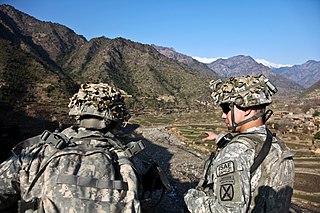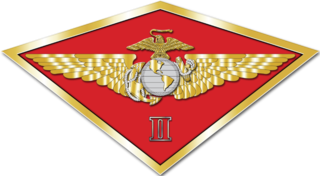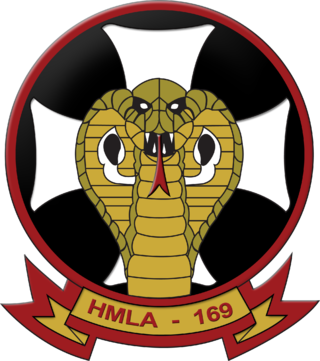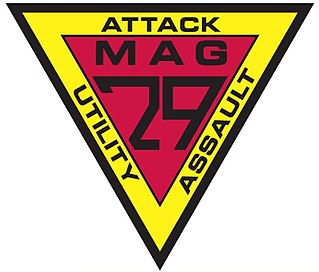Related Research Articles

Operation Enduring Freedom (OEF) was the official name used by the U.S. government for both the first stage (2001–2014) of the War in Afghanistan (2001–2021) and the larger-scale Global War on Terrorism. On 7 October 2001, in response to the September 11 attacks, President George W. Bush announced that airstrikes against Al-Qaeda and the Taliban had begun in Afghanistan. Beyond the military actions in Afghanistan, Operation Enduring Freedom was also affiliated with counterterrorism operations in other countries, such as OEF-Philippines and OEF-Trans Sahara.

The International Security Assistance Force (ISAF) was a multinational military mission in Afghanistan from 2001 to 2014. It was established by United Nations Security Council Resolution 1386 according to the Bonn Agreement, which outlined the establishment of a permanent Afghan government following the U.S. invasion in October 2001. ISAF's primary goal was to train the Afghan National Security Forces (ANSF) and assist Afghanistan in rebuilding key government institutions; it gradually took part in the broader war in Afghanistan against the Taliban insurgency.
In Operation Mountain Viper, the United States Army and the Afghan National Army worked together from August 30 to early September, 2003, to uncover hundreds of suspected Taliban rebels dug into the mountains of Daychopan district, Zabul province, Afghanistan.
Operation Eagle Fury was a military operation led by the United States in Afghanistan involving Bravo Company and two Charlie Company SFODAs, 2nd BN, 7th SFG(A) US Army Special Forces, and a sniper team of USN SEALs, members of the QRF 82nd Airborne Division, and loyal Afghan fighters from 9–28 February 2003. The aim of the operation was to corner Taliban fighters and leaders in the Baghran Valley, located in Helmand Province, in the mountains of south-east Afghanistan. The battle took place in the village of Lejay for 43 consecutive hours. This continues to be the longest solely Special Forces battle to take place during the Afghanistan war.

The 2nd Marine Aircraft Wing is the major east coast aviation unit of the United States Marine Corps and is headquartered in Marine Corps Air Station Cherry Point, North Carolina. The Wing provides the aviation combat element for the II Marine Expeditionary Force.

Marine Aircraft Group 39 (MAG-39) is a United States Marine Corps aviation unit based at Marine Corps Base Camp Pendleton, California that is currently composed of four AH-1Z "Viper" Cobra and UH-1Y "Venom" Huey light attack squadrons, two MV-22 Osprey squadrons, an aviation logistics squadron, a Headquarters Squadron, a Marine Wing Support Squadron and the H-1 Fleet Replacement Squadron. The group falls under the command of the 3rd Marine Aircraft Wing and the 1st Marine Expeditionary Force

Marine Light Attack Helicopter Squadron 169 (HMLA-169) is a United States Marine Corps helicopter squadron consisting of AH-1Z Viper attack helicopters and UH-1Y Venom utility helicopters. The squadron is based at Marine Corps Air Station Camp Pendleton, California and falls under the command of Marine Aircraft Group 39 (MAG-39) and the 3rd Marine Aircraft Wing.

Marine Light Attack Helicopter Squadron 773 (HMLA-773) is a United States Marine Corps helicopter squadron consisting of Bell AH-1Z Viper attack helicopters and Bell UH-1Y Venom utility helicopters. The squadron is based at Joint Base McGuire–Dix–Lakehurst, NJ and Naval Air Station Joint Reserve Base New Orleans and falls under the command of Marine Aircraft Group 49 (MAG-49) and the 4th Marine Aircraft Wing.

Marine Aircraft Group 29 (MAG-29) is a United States Marine Corps aviation unit based at Marine Corps Air Station New River, North Carolina. The group is currently composed of four CH-53E Super Stallion squadrons including the Fleet Replacement Squadron, two Light Attack Helicopter Squadrons flying AH-1Z Vipers and UH-1Y Venoms, and a maintenance and logistics squadron.

Eristicophis is a monotypic genus created for the viper species, Eristicophis macmahonii, which is endemic to the desert region of Balochistan near the borders of Iran, Pakistan, and Afghanistan. Common names for the species include McMahon's viper, Asian sand viper, leaf-nosed viper, and whiskered viper. Like all other vipers, it is venomous. No subspecies are currently recognized.

Echis carinatus multisquamatus, known as the multiscale saw-scaled viper and transcaspian saw-scaled viper, is a viper subspecies found in Uzbekistan, Turkmenistan, Iran, Afghanistan, and Pakistan. Like all other vipers, it is venomous.

Echis carinatus sochureki is a venomous viper subspecies found in India, Pakistan, Afghanistan, Iran, and parts of the Arabian Peninsula.

The Mountain Warfare Training Center (MWTC) is a United States Marine Corps installation located in Pickel Meadows in Mono County, California, at 6,800 feet (2,100 m) above sea level in the Toiyabe National Forest, 21 miles (34 km) northwest of Bridgeport, California. The training center exists to train units in complex compartmented terrain.

Embedded Training Teams or ETT is the term used by the US military since 2003 to describe conventional forces used to train and mentor Afghan forces. They were formed in 2003 under Task Force Phoenix. Although ETT refers to the Embedded Training "Team", members of the team itself commonly refer to themselves as "ETTs"

The war on terror, officially Global War on Terrorism (GWOT), is a global military campaign initiated by the United States following the September 11 attacks in 2001, and is the most recent global conflict spanning multiple wars. Some researchers and political scientists have argued that it replaced the Cold War.

The 1st Brigade Combat Team, 10th Mountain Division is an active Infantry Brigade Combat Team of the United States Army based at Fort Drum in New York. The brigade headquarters carries the lineage of the 10th Mountain Division's original headquarters company, and served as such in World War II, and in peacetime at Fort Riley, Fort Benning, and West Germany in the 1940s and 1950s.

The Korps Commandotroepen (KCT) is the elite special forces unit of the Royal Netherlands Army. The KCT traces its origins to the Second World War with the founding of No. 2 (Dutch) Troop, and the founding of the Korps Speciale Troepen during the Indonesian War of Independence. At present, the unit is tasked with conducting the full spectrum of special operations, its principal tasks being direct action, special reconnaissance, military assistance and counter-terrorism.
Combined Joint Task Force 180 was a provisional multinational land formation, primarily made up of units from the United States Army, that fought in the War in Afghanistan (2001–2021), especially in the initial invasion phase of 2001-2002. It was active from May 2002 to 2003/05. It was the senior headquarters in country reporting to United States Central Command.
Major General Phillip David Prosser CBE is a British Army officer and engineer, who currently serves as Director Joint Support, UK Strategic Command. He previously served in the Royal Electrical and Mechanical Engineers, and was commander of 101 Logistic Brigade based in Aldershot. During the COVID-19 pandemic, Prosser was head of the Army's Operation Iron Viper to help Britain's National Health Service administer vaccines against the coronavirus.
References
- ↑ Clements, Frank; Adamec, Ludwig W. (2003). Conflict in Afghanistan: A Historical Encyclopedia. ABC-CLIO. pp. 63–64. ISBN 9781851094028.